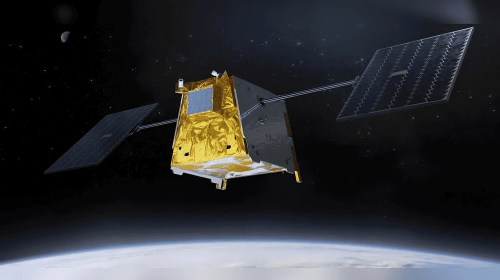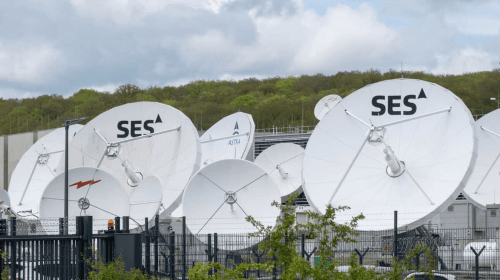Feb 16, 2018
Most satellite networks are based on a star, or hub and spoke architecture, in which all the remote sites connect back to a central hub that is responsible for allocating bandwidth and managing, aggregating and routing traffic. What happens when a remote site in City A wants to have a VoIP (Voice over IP) call with another remote site in City B? If they are both connected to a central hub that means their voice traffic has to flow from Remote/City A up to the satellite, down to the Hub, then back up to the satellite, and down again, to Remote/City B. The same traffic has to go over the satellite twice, doubling the amount of bandwidth used for that traffic.
The distance from the earth’s surface to a satellite above is 35,786 km (22,236 mi), and the total distance the voice traffic has to travel between remote sites, going up and down twice, is 143,144 km (88,944 miles). The actual distance is going to be greater than this as the Hub and the remote sites are highly unlikely to be directly under the satellite on the equator. Drawing a triangle from hub to satellite to remote, we can get the total distance the signal has to travel. When we divide the total distance, by the speed of light (299,792,458 meters per second or 186,000 miles per second) – the speed at which satellite signals travel, we find that a round trip “ping” is going to take about 1.2 seconds. This makes the VoIP call, more like a walkie-talkie radio call. The same is true for video calls. To avoid interrupting or stepping on each other, people on a double-hop call must learn to ask a question, then stop and wait a while for the response to come back.
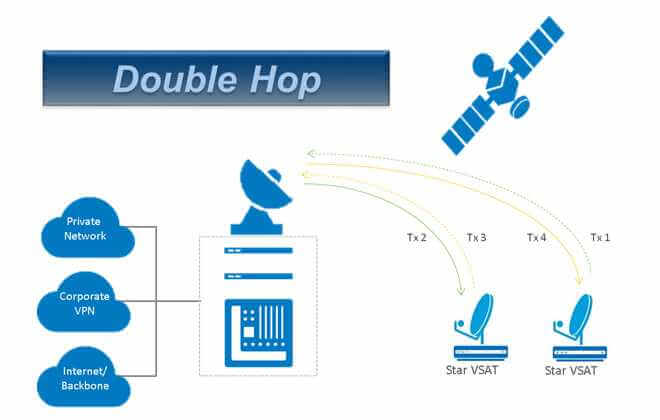
Mesh networks eliminate this problem. In a mesh network a remote site in City A can send traffic to another remote in City B, without going through the central Hub. That means the VoIP call or other traffic goes over the satellite just once. Advantages extend to data transmissions as well. If remote sites are connected to a hub in a star, and they send a lot of files to each other, those files have to go through the hub, which means going over the satellite twice. As with VoIP traffic, a mesh solution reduces by half, the amount of bandwidth needed to send files from one remote site to another remote site. However, voice and video traffic between remote sites, is a frequent request from enterprise clients supporting private networks with multiple remote branch offices. Most clients do not understand the double-hop limitation and are disappointed to learn the limitations and costs of legacy mesh solutions.
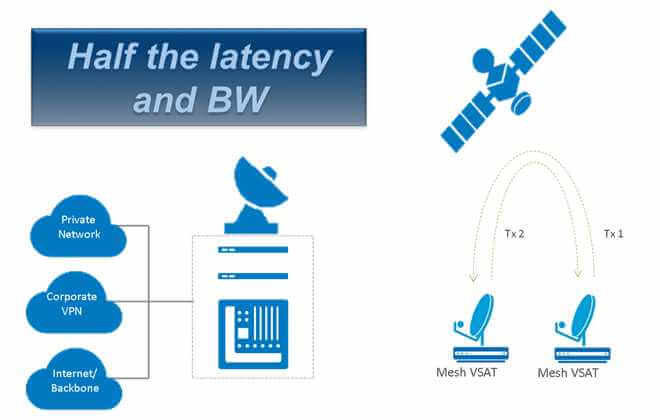
iDirect began offering mesh capabilities over 10 years ago, using the legacy iNFINITI platform. That platform has been discontinued, with tech support continuing till the end of 2018. The iNFINITI platform did support mesh connections, but it was not a very scalable solution. If there were a lot of remotes and a lot of remote to remote calls or data transfers active, the carrier sizes, and thus the VSAT hardware to support them, quickly got out of hand. The solution didn’t scale well and was suitable mostly for small mesh networks with a handful of sites. iDirect’s new Evolution® Multi-Carrier Mesh solution resolves the scalability issue, supporting up to a 5000 site mesh or star topology.
The Multi-Carrier Mesh solution leverages iDirect’s “Pay as you Grow” hub architecture, which allows the hub to be upgraded incrementally. It features the industry-leading Group QoS capability, as well as the user-friendly, full featured iVantage Network Management System. From a technical perspective, the solution supports the latest waveform advancements including 32APSK and 5% ROF for star topology downstream carrier. The normal ROF or “roll off factor” is around 20%. What this means is increased efficiency, as less satellite capacity is used to separate or isolate the download carrier from other carriers. On the upload, 8PSK, QPSK and BPSK are supported for mesh topology TDMA carriers.
Other technical parameters include support for .468 to 7.5 Msps per carrier, with an aggregate of 29 Msps for each inroute group. Each inroute group can have up to 3000 time slots per 125 ms TDMA frame. All are non-spread TDMA modcods (modulation & coding) with 170B payload.
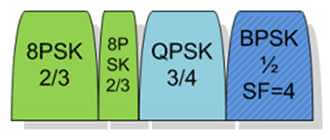
An advantage of iDirect’s common hub infrastructure for star and mesh is the ability to share the same hub, line cards and servers. Star and mesh can share the same DVB-S2 outbound (download to remotes), and they can share the same inroute groups (upload carriers). iDirect’s “adaptive TDMA technology supports the idea of bundling multiple carriers together and treating them as a single pool of bandwidth. In the past, all carriers that were members of an inroute group had to be identical, but in Operating System iDX 3.2, this restriction was removed so that carriers in an inroute group can now have different symbol rates, modulations, Forward Error Correction (FEC) coding rates, and spread factors. These features are available to Mesh VSAT as well as Star VSAT remote sites. This all means it costs very little to add mesh capability to an existing iDirect hub.
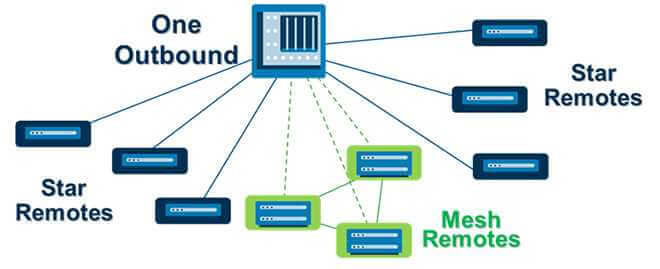
To implement the iDirect Evolution Multi-Carrier Mesh Solution, the powerful iDirect X7 remote modem/router is coupled with the “Mesh Receiver.” This is a 2U solution when rack-mounted. The combined X7/Mesh Receiver platform can support up to 16 simultaneous receive channels. (iNFINITI supported one). With this solution, remotes that need mesh connectivity can be spread out over multiple small carriers, instead of all sharing one very large carrier, which can greatly reduce the VSAT antenna and transmitter requirements.
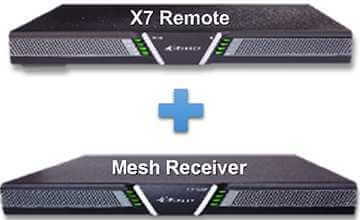
The carriers support a wide range of bandwidth options. Multiple carriers can be assigned to inroute groups which can support a large number of sites, in a wide variety of configurations. When the hub is communicating with mesh remotes, it uses multicast and AES-256 encryption. When a mesh site is communicating with another site or the hub, it supports Unicast UDP and accelerated TCP*.
A very important and critical advantage of the iDirect solution is the support for multiple carriers. Competitive mesh offerings generally support only one demodulator (demod), so all sites that want to be part of the mesh, must be on the same carrier. Some offerings provide expensive options such as stacking up to four demods per site.
Consider a possible scenario. We have a bank with 20 branch offices. The corporate office or data center is on terrestrial high speed internet. The branch offices need to a) have access to the internet, b) have access to the data center or cloud resources, c) communicate between themselves with VoIP and file transfers.
Let’s assume we’ve determined that the internet and corporate traffic will require 15 Mbps x 3.5 Mbps to be shared by all 20 sites. Next we determine that among the 20 sites, there will be 16 active inter-office VoIP calls during peak busy hours. Each call will require 16 Kbps to send and 16 Kbps to receive, thus we have a total of 16 x 32 Kbps = .512 Mbps. Finally, our analysis tells us we need 1 Mbps to be used for site to site file transfers. This gives us a mesh carrier of 3.5 Mbps for internet and corporate data, .5 Mbps for internal VoIP traffic, and 1 Mbps for internal file transfer, or a total of 5 Mbps. If all 20 remote sites have to share the same carrier, as they would with most competing solutions, then every site will need the antenna and BUC (transmitter equipment) to support a 5 Mbps inroute or mesh carrier. If this network doubles in size (number of sites and/or amount of bandwidth), there is no easy migration or expansion path beyond upgrading all the ODU (outdoor unit) at the remote sites.
iDirect’s Multi-Carrier Mesh solution does away with the need for all communicating sites to share the same carrier. Now the traffic can be divided across multiple smaller carriers, and the ODU can be reduced to more reasonably sized antennas and BUCs. Instead of one 5 Mbps mesh carrier, it might make more sense to have five 1 Mbps mesh carriers, and keep the VSAT equipment on the ground small. Due to the need to put so much traffic on one very large shared carrier, most mesh projects end up being abandoned. Now they can be affordable – and very flexible.
iDirect’s solution supports frequency hopping for both star and mesh networks, an important advantage. We’ve divided our 20 sites across five 1 Mbps inroute carriers, for example. Now we have small antennas and BUCs at all our sites. We have four sites on each 1 Mbps carrier. If these sites were permanently assigned to a particular carrier, then situations would arise where the assigned carrier is congested, but one of the other carriers has idle capacity. Frequency hopping allows the hub to assign remotes to transmit on carriers that have available capacity – on the fly. They can take advantage of idle capacity in any carrier within the inroute group that their ODU will support. Thus instead of remote sites sharing individual carriers, an entire group of carriers (adaptive inroute group) is shared by the remote sites, and treated as a single pool of capacity. Frequency hopping can produce a huge gain in efficiency, and this advantage extends to mesh networks as well as star.
The iDirect Multi-Carrier Mesh solution supports three models:
- 1. Full mesh to full mesh. Any remote site can communicate with any other remote site over a single satellite hop
- 2. Full mesh to hub. Any remote site may communicate with the Hub in a star, generally for internet access or cloud computing.
- 3. Hop-and-a-half to full mesh. This interesting option reduces costs, but adds latency. A remote operating in star mode can transmit with a single hop to a Mesh VSAT. The Mesh VSAT can then forward the transmission to the hub, which will forward it back to the Star VSAT.
An example might help with the hop-and-a-half scenario. Remote sites that are designated Mesh VSAT will deploy the X7 and Mesh Receiver. Every remote site that wants to listen for single-hop mesh traffic, will need the Mesh Receiver. To reduce costs, some Star VSATs may be deployed with just the X7, and no Mesh Receiver. Let’s say Bob at Star VSAT Site 1 wants to talk with Alice in the regional office at Mesh VSAT Site 2. Bob’s “Hello” goes from his site to Alice’s site with a single satellite hop (300 ms). Since Bob’s site does not have a Mesh Receiver, Alice’s Mesh VSAT site forwards her “Hi Bob. How are you?” response to the central Physical Hub (300 ms) which in turn forwards it to Bob’s Star VSAT (300 ms), for a total trip of 900 ms. This is better than 1.2 ms latency in a double hop, it saves having to buy Mesh Receivers for all sites, and it still saves bandwidth as compared with a full double-hop star connection.
iDirect’s Mesh Receiver also operates as a logical hub or regional gateway, providing a Star in a Star topology. Picture a distributed network with regional data centers, each supporting a number of branch offices. The remote branch offices can communicate directly with the central Hub that provides access to the internet, and they can communicate with either a single hop or a hop-and-a half with regional data centers where corporate servers and resources may be located. Each Regional office can act as the center of a star for branch offices, while themselves operating as spokes to a central Physical Hub, providing a structured, distribution of corporate computing resources from headquarters to regional office to branch office. Branch offices connect in a star to a regional office, which in turn connect via star to the Hub.
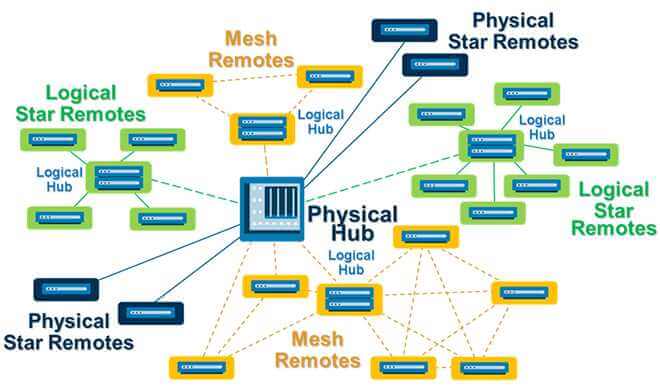
Based on the proven Evolution platform, the iDirect Multi-carrier Mesh Solution currently appears to be the most advanced and flexible mesh system on the market today. It reduces hardware costs by leveraging multi-channel demodulators, so that smaller carriers and ODU can be supported. It has very high receiver throughput (29 Msps). It supports all the latest Evolution waveforms and spectral efficiency advances in both star and mesh bandwidth sharing. The flexibility provides for a perfect balance between capital and operational expenditures by supporting a mix of star, mesh and mesh Transmit-Only (Hop-and-a-half) terminals.
BusinessCom was one of the first iDirect-enabled service providers to deliver broadband satellite services in Africa and the eastern hemisphere, beginning nearly 15 years ago. We now deliver these services around the globe. We are prepared to assist with questions and the design of networks that leverage iDirect’s new mesh capability, and to contrast that solution with those of other vendors, in order to deliver the best possible solutions for our clients.
*TCP Acceleration between mesh remotes not available in first release

